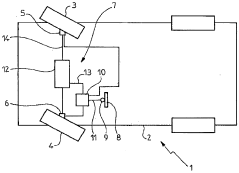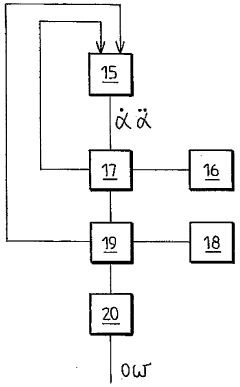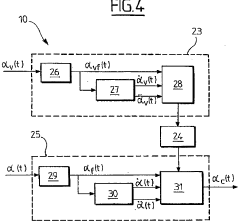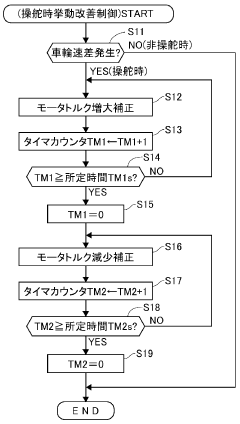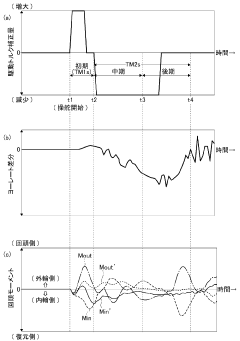How to Improve Steering Wheel Response Time in Automobiles?
JUL 18, 20259 MIN READ
Generate Your Research Report Instantly with AI Agent
Patsnap Eureka helps you evaluate technical feasibility & market potential.
Steering Response Evolution and Objectives
The evolution of steering wheel response in automobiles has been a continuous journey of technological advancement, driven by the ever-increasing demands for safety, comfort, and performance. From the early days of manual steering systems to today's sophisticated electronic power steering (EPS) setups, the automotive industry has made significant strides in improving the responsiveness and precision of steering mechanisms.
In the early 20th century, steering systems were purely mechanical, relying on direct linkages between the steering wheel and the wheels. As vehicles became heavier and more complex, hydraulic power steering was introduced in the 1950s, marking a significant leap in reducing driver effort and improving maneuverability. This technology remained dominant for several decades, undergoing incremental improvements in efficiency and responsiveness.
The late 1990s and early 2000s saw the emergence of electric power steering systems, which offered numerous advantages over hydraulic systems, including improved fuel efficiency, reduced maintenance, and greater flexibility in tuning steering feel. This shift towards electronic systems opened up new possibilities for enhancing steering response time and precision.
Recent years have witnessed a focus on reducing steering response time, which is crucial for both safety and driving experience. The objective is to minimize the delay between the driver's input at the steering wheel and the corresponding movement of the vehicle's wheels. This improvement is particularly critical in emergency maneuvers and high-speed driving scenarios, where split-second reactions can make a significant difference.
Current technological objectives in steering response improvement include the development of more advanced sensors and control algorithms to predict driver intentions and road conditions. These systems aim to provide instantaneous feedback and adjust steering assistance in real-time, enhancing both responsiveness and stability.
Another key goal is the integration of steering systems with other vehicle dynamics control systems, such as electronic stability control (ESC) and active suspension. This holistic approach allows for more coordinated vehicle responses, further improving overall handling and safety.
As the automotive industry moves towards autonomous driving technologies, steering systems are evolving to accommodate both human and computer inputs. The objective is to create seamless transitions between manual and autonomous control, maintaining optimal response times in all scenarios.
Looking ahead, the industry is exploring innovative technologies such as steer-by-wire systems, which completely eliminate mechanical linkages between the steering wheel and wheels. These systems promise even faster response times and greater customization of steering feel, though they face challenges in terms of reliability and regulatory approval.
In the early 20th century, steering systems were purely mechanical, relying on direct linkages between the steering wheel and the wheels. As vehicles became heavier and more complex, hydraulic power steering was introduced in the 1950s, marking a significant leap in reducing driver effort and improving maneuverability. This technology remained dominant for several decades, undergoing incremental improvements in efficiency and responsiveness.
The late 1990s and early 2000s saw the emergence of electric power steering systems, which offered numerous advantages over hydraulic systems, including improved fuel efficiency, reduced maintenance, and greater flexibility in tuning steering feel. This shift towards electronic systems opened up new possibilities for enhancing steering response time and precision.
Recent years have witnessed a focus on reducing steering response time, which is crucial for both safety and driving experience. The objective is to minimize the delay between the driver's input at the steering wheel and the corresponding movement of the vehicle's wheels. This improvement is particularly critical in emergency maneuvers and high-speed driving scenarios, where split-second reactions can make a significant difference.
Current technological objectives in steering response improvement include the development of more advanced sensors and control algorithms to predict driver intentions and road conditions. These systems aim to provide instantaneous feedback and adjust steering assistance in real-time, enhancing both responsiveness and stability.
Another key goal is the integration of steering systems with other vehicle dynamics control systems, such as electronic stability control (ESC) and active suspension. This holistic approach allows for more coordinated vehicle responses, further improving overall handling and safety.
As the automotive industry moves towards autonomous driving technologies, steering systems are evolving to accommodate both human and computer inputs. The objective is to create seamless transitions between manual and autonomous control, maintaining optimal response times in all scenarios.
Looking ahead, the industry is exploring innovative technologies such as steer-by-wire systems, which completely eliminate mechanical linkages between the steering wheel and wheels. These systems promise even faster response times and greater customization of steering feel, though they face challenges in terms of reliability and regulatory approval.
Market Demand Analysis for Responsive Steering
The market demand for responsive steering in automobiles has been steadily increasing in recent years, driven by a combination of consumer preferences, safety considerations, and technological advancements. As vehicles become more sophisticated and drivers expect higher levels of performance, the importance of quick and precise steering response has become a key differentiator in the automotive industry.
Consumer surveys consistently show that drivers prioritize handling and responsiveness as crucial factors in their vehicle purchasing decisions. A study by J.D. Power revealed that steering feel and responsiveness rank among the top five attributes influencing customer satisfaction in the premium vehicle segment. This trend is not limited to high-end vehicles, as even mid-range and economy car buyers are showing increased interest in improved steering performance.
Safety considerations play a significant role in driving market demand for responsive steering. Quicker steering response times can be critical in emergency situations, allowing drivers to react more effectively to sudden obstacles or changes in road conditions. The National Highway Traffic Safety Administration (NHTSA) has emphasized the importance of vehicle maneuverability in accident prevention, further underscoring the need for advanced steering systems.
The growing popularity of electric and hybrid vehicles has also contributed to the demand for improved steering response. These vehicles often have different weight distributions and handling characteristics compared to traditional internal combustion engine cars, necessitating more sophisticated steering systems to maintain optimal performance and driver feel.
Market analysts project that the global automotive steering system market will experience substantial growth in the coming years. Factors such as increasing vehicle production, rising demand for electric power steering systems, and the integration of advanced driver assistance systems (ADAS) are expected to drive this growth. The Asia-Pacific region, in particular, is anticipated to witness significant expansion in this market due to the rapid growth of the automotive industry in countries like China and India.
Automotive manufacturers are responding to this demand by investing heavily in research and development of advanced steering technologies. This includes the development of steer-by-wire systems, which eliminate the mechanical connection between the steering wheel and the wheels, allowing for faster response times and greater customization of steering feel. Additionally, the integration of artificial intelligence and machine learning algorithms into steering systems is enabling more adaptive and responsive steering behavior based on driving conditions and driver preferences.
As autonomous driving technology continues to evolve, the importance of precise and responsive steering becomes even more critical. Self-driving vehicles require highly accurate and quick-reacting steering systems to navigate complex traffic scenarios and ensure passenger safety. This emerging trend is expected to further fuel innovation and market growth in the automotive steering sector.
Consumer surveys consistently show that drivers prioritize handling and responsiveness as crucial factors in their vehicle purchasing decisions. A study by J.D. Power revealed that steering feel and responsiveness rank among the top five attributes influencing customer satisfaction in the premium vehicle segment. This trend is not limited to high-end vehicles, as even mid-range and economy car buyers are showing increased interest in improved steering performance.
Safety considerations play a significant role in driving market demand for responsive steering. Quicker steering response times can be critical in emergency situations, allowing drivers to react more effectively to sudden obstacles or changes in road conditions. The National Highway Traffic Safety Administration (NHTSA) has emphasized the importance of vehicle maneuverability in accident prevention, further underscoring the need for advanced steering systems.
The growing popularity of electric and hybrid vehicles has also contributed to the demand for improved steering response. These vehicles often have different weight distributions and handling characteristics compared to traditional internal combustion engine cars, necessitating more sophisticated steering systems to maintain optimal performance and driver feel.
Market analysts project that the global automotive steering system market will experience substantial growth in the coming years. Factors such as increasing vehicle production, rising demand for electric power steering systems, and the integration of advanced driver assistance systems (ADAS) are expected to drive this growth. The Asia-Pacific region, in particular, is anticipated to witness significant expansion in this market due to the rapid growth of the automotive industry in countries like China and India.
Automotive manufacturers are responding to this demand by investing heavily in research and development of advanced steering technologies. This includes the development of steer-by-wire systems, which eliminate the mechanical connection between the steering wheel and the wheels, allowing for faster response times and greater customization of steering feel. Additionally, the integration of artificial intelligence and machine learning algorithms into steering systems is enabling more adaptive and responsive steering behavior based on driving conditions and driver preferences.
As autonomous driving technology continues to evolve, the importance of precise and responsive steering becomes even more critical. Self-driving vehicles require highly accurate and quick-reacting steering systems to navigate complex traffic scenarios and ensure passenger safety. This emerging trend is expected to further fuel innovation and market growth in the automotive steering sector.
Current Challenges in Steering Response Time
The current challenges in steering response time for automobiles are multifaceted and stem from various technological and design factors. One of the primary issues is the mechanical lag inherent in traditional hydraulic power steering systems. These systems, while reliable, introduce a delay between the driver's input and the actual wheel movement due to the time required for hydraulic fluid to flow and pressurize.
Another significant challenge is the complexity of modern vehicle control systems. As cars become more sophisticated, with advanced driver assistance features and electronic stability controls, the integration of steering systems with these technologies can introduce additional processing time, affecting overall response.
The increasing prevalence of electric power steering (EPS) systems, while offering improvements in efficiency and customization, presents its own set of challenges. EPS systems rely on complex algorithms to interpret driver input and road conditions, which can sometimes result in a perceived lag or artificial feel in steering response.
Weight distribution and vehicle dynamics also play a crucial role in steering response time. As vehicles become heavier due to added safety features and battery packs in electric vehicles, the inertia of the vehicle increases, potentially slowing down the steering response.
Tire design and road surface interaction present another challenge. The compliance of modern tires, designed for comfort and fuel efficiency, can introduce a delay in force transmission from the steering wheel to the road surface, affecting the overall steering response time.
The human factor cannot be overlooked. Driver expectations and perceptions of steering feel vary widely, making it challenging to design a universally satisfactory steering response. What feels responsive to one driver may feel overly sensitive to another, necessitating a delicate balance in system tuning.
Environmental factors such as temperature variations and road conditions further complicate the issue. Steering systems must maintain consistent performance across a wide range of operating conditions, from icy roads to hot asphalt, each presenting unique challenges to response time.
Lastly, the pursuit of improved fuel efficiency has led to the adoption of technologies like electric power steering assist, which, while more efficient, can sometimes compromise the direct mechanical connection between the steering wheel and the road, potentially affecting response time and driver feedback.
Addressing these challenges requires a holistic approach, combining advancements in mechanical engineering, electronic control systems, and material science to create steering systems that are both responsive and adaptable to various driving conditions and driver preferences.
Another significant challenge is the complexity of modern vehicle control systems. As cars become more sophisticated, with advanced driver assistance features and electronic stability controls, the integration of steering systems with these technologies can introduce additional processing time, affecting overall response.
The increasing prevalence of electric power steering (EPS) systems, while offering improvements in efficiency and customization, presents its own set of challenges. EPS systems rely on complex algorithms to interpret driver input and road conditions, which can sometimes result in a perceived lag or artificial feel in steering response.
Weight distribution and vehicle dynamics also play a crucial role in steering response time. As vehicles become heavier due to added safety features and battery packs in electric vehicles, the inertia of the vehicle increases, potentially slowing down the steering response.
Tire design and road surface interaction present another challenge. The compliance of modern tires, designed for comfort and fuel efficiency, can introduce a delay in force transmission from the steering wheel to the road surface, affecting the overall steering response time.
The human factor cannot be overlooked. Driver expectations and perceptions of steering feel vary widely, making it challenging to design a universally satisfactory steering response. What feels responsive to one driver may feel overly sensitive to another, necessitating a delicate balance in system tuning.
Environmental factors such as temperature variations and road conditions further complicate the issue. Steering systems must maintain consistent performance across a wide range of operating conditions, from icy roads to hot asphalt, each presenting unique challenges to response time.
Lastly, the pursuit of improved fuel efficiency has led to the adoption of technologies like electric power steering assist, which, while more efficient, can sometimes compromise the direct mechanical connection between the steering wheel and the road, potentially affecting response time and driver feedback.
Addressing these challenges requires a holistic approach, combining advancements in mechanical engineering, electronic control systems, and material science to create steering systems that are both responsive and adaptable to various driving conditions and driver preferences.
Existing Steering Response Enhancement Solutions
01 Steering control systems for improved response time
Advanced steering control systems are designed to enhance the response time of steering wheels. These systems often incorporate sensors, actuators, and electronic control units to quickly process driver inputs and adjust steering behavior accordingly. By reducing the delay between driver input and vehicle response, these systems improve overall handling and safety.- Adaptive steering systems: Adaptive steering systems adjust the steering response based on vehicle speed and driving conditions. These systems can modify the steering ratio or assist force to improve handling and responsiveness at different speeds, enhancing overall steering wheel response time.
- Electronic power steering control: Electronic power steering systems use sensors and control algorithms to optimize steering response. These systems can adjust the level of power assistance and steering feel based on various parameters, reducing response time and improving steering precision.
- Steer-by-wire technology: Steer-by-wire systems eliminate the mechanical connection between the steering wheel and the wheels, using electronic controls and actuators instead. This technology allows for faster response times and more precise steering control, as well as customizable steering characteristics.
- Variable-ratio steering mechanisms: Variable-ratio steering mechanisms change the steering ratio based on steering wheel angle or vehicle speed. These systems can provide quicker response for small steering inputs while maintaining stability for larger inputs, improving overall steering responsiveness.
- Steering feel simulation and feedback: Advanced steering systems incorporate force feedback and haptic technologies to simulate realistic steering feel. These systems can provide immediate tactile feedback to the driver, enhancing the perception of steering response and improving overall vehicle control.
02 Variable steering ratio mechanisms
Variable steering ratio mechanisms adjust the relationship between steering wheel movement and wheel angle based on vehicle speed and other factors. This technology allows for quicker steering response at low speeds for improved maneuverability, while providing more stability at higher speeds. The result is a more responsive and adaptable steering system across various driving conditions.Expand Specific Solutions03 Electric power steering systems for faster response
Electric power steering systems utilize electric motors to assist in steering, replacing traditional hydraulic systems. These systems can provide faster and more precise steering assistance, reducing the delay in steering response. They also allow for easier integration of advanced driver assistance features and can be tuned for optimal performance across different driving modes.Expand Specific Solutions04 Steer-by-wire technology
Steer-by-wire systems eliminate the mechanical connection between the steering wheel and the wheels, replacing it with electronic controls and actuators. This technology allows for instantaneous steering response and the ability to adjust steering feel and feedback. It also enables advanced features such as variable steering ratios and integration with autonomous driving systems.Expand Specific Solutions05 Adaptive steering systems
Adaptive steering systems use advanced algorithms and sensors to continuously adjust steering parameters based on driving conditions, vehicle speed, and driver inputs. These systems can optimize steering response time by predicting driver intentions and pre-adjusting steering characteristics. They often incorporate machine learning techniques to improve performance over time and provide a more responsive driving experience.Expand Specific Solutions
Key Automotive Steering System Manufacturers
The steering wheel response time improvement in automobiles is currently in a mature development stage, with significant market potential due to increasing demand for enhanced driving experiences and safety features. The global automotive steering systems market is projected to grow substantially, driven by technological advancements and the rise of electric and autonomous vehicles. Major players like ZF Friedrichshafen, Toyota, Nissan, and Honda are investing heavily in research and development to enhance steering technologies. These companies, along with others such as Renault, Volkswagen, and Mercedes-Benz, are focusing on integrating advanced electronic steering systems, adaptive steering, and steer-by-wire technologies to improve response times and overall vehicle performance. The competition is fierce, with both established automakers and emerging tech companies like ClearMotion contributing to innovations in this field.
ZF Friedrichshafen AG
Technical Solution: ZF has developed an advanced steer-by-wire system that eliminates the mechanical connection between the steering wheel and wheels, reducing response time significantly. Their system uses redundant electronic control units and actuators to ensure safety and reliability. ZF's solution incorporates a force feedback actuator that simulates road feel, providing drivers with a natural steering experience. The system allows for variable steering ratios, adapting to different driving conditions and speeds for optimal responsiveness[1][3]. Additionally, ZF has integrated their steer-by-wire technology with advanced driver assistance systems (ADAS) to further enhance steering precision and response time.
Strengths: Highly responsive, adaptable to various driving conditions, integrates well with ADAS. Weaknesses: Requires significant changes to traditional steering architecture, potential concerns about system reliability in case of electronic failures.
GM Global Technology Operations LLC
Technical Solution: GM has introduced a Variable Effort Electric Power Steering (EPS) system to improve steering wheel response time. This system uses an electric motor to assist steering, replacing traditional hydraulic systems. The Variable Effort feature adjusts steering assistance based on vehicle speed and driver input, providing quicker response at low speeds and more stability at high speeds. GM's system also incorporates a torque overlay function, allowing for subtle steering corrections in semi-autonomous driving modes[2]. The company has further enhanced their EPS with advanced algorithms that compensate for road crown and crosswinds, reducing driver fatigue and improving overall steering responsiveness[4].
Strengths: Improved fuel efficiency, seamless integration with driver assistance features, adaptable to different driving conditions. Weaknesses: May lack the traditional "feel" that some drivers prefer, potential for increased complexity in the steering system.
Innovative Steering Response Technologies
Method and system for assisting the steering of steered wheels of a vehicle thus equipped
PatentWO2005075277A1
Innovation
- A phase advance is applied between the steering wheel and the rack element to reduce the vehicle's response time by measuring and estimating the speed of rotation and angular acceleration of the steering wheel, using a control unit to calculate a steering setpoint and apply a timing advance, which can be between 10 and 100 milliseconds, to improve the dynamic characteristics and safety of the vehicle.
Device for improving vehicle behavior when steering
PatentWO2011136024A1
Innovation
- A steering behavior improvement device that temporarily increases the driving force to the wheels during steering, enhancing the turning moment and yaw rate of the vehicle without altering suspension rigidity or shock absorber damping force, thereby improving steering response and roll behavior.
Safety Regulations for Steering Systems
Safety regulations for steering systems in automobiles are critical to ensure the reliability and performance of steering wheel response time. These regulations are established by various governmental and international bodies to maintain consistent standards across the automotive industry. The National Highway Traffic Safety Administration (NHTSA) in the United States, for instance, sets forth Federal Motor Vehicle Safety Standards (FMVSS) that directly address steering control systems.
One of the key regulations is FMVSS No. 203, which specifies requirements for steering control systems to minimize chest, neck, and facial injuries in the event of a crash. This standard indirectly influences steering wheel response time by mandating certain structural and design elements that can affect the overall steering system performance.
The United Nations Economic Commission for Europe (UNECE) also plays a significant role in establishing international standards. Regulation No. 79 of the UNECE specifically deals with steering equipment and its uniform provisions. This regulation sets guidelines for steering effort, turn radius, and the overall steering system's ability to maintain vehicle control, all of which are integral to improving steering wheel response time.
In the European Union, the General Safety Regulation (EU) 2019/2144 outlines requirements for type-approval of motor vehicles and their trailers, including systems and components. This regulation encompasses advanced driver assistance systems and automated driving technologies, which are increasingly relevant to steering response improvements.
Safety regulations also address the integration of electronic steering systems, such as Electric Power Steering (EPS) and Steer-by-Wire technologies. These systems must comply with functional safety standards like ISO 26262, which is specific to road vehicles' electrical and electronic systems. This standard ensures that electronic steering components meet rigorous safety and reliability requirements, directly impacting response time and overall system performance.
Moreover, regulations often stipulate performance criteria for steering systems under various conditions. For example, they may specify maximum allowable steering forces at different vehicle speeds or mandate certain levels of steering precision and responsiveness. These requirements drive innovation in steering system design and contribute to ongoing improvements in response time.
As autonomous driving technologies advance, new regulations are being developed to address the unique challenges posed by these systems. For instance, the UNECE has introduced Regulation No. 157 on Automated Lane Keeping Systems (ALKS), which includes provisions for steering control in automated driving modes. These emerging regulations will continue to shape the development of steering systems and their response characteristics in future vehicles.
One of the key regulations is FMVSS No. 203, which specifies requirements for steering control systems to minimize chest, neck, and facial injuries in the event of a crash. This standard indirectly influences steering wheel response time by mandating certain structural and design elements that can affect the overall steering system performance.
The United Nations Economic Commission for Europe (UNECE) also plays a significant role in establishing international standards. Regulation No. 79 of the UNECE specifically deals with steering equipment and its uniform provisions. This regulation sets guidelines for steering effort, turn radius, and the overall steering system's ability to maintain vehicle control, all of which are integral to improving steering wheel response time.
In the European Union, the General Safety Regulation (EU) 2019/2144 outlines requirements for type-approval of motor vehicles and their trailers, including systems and components. This regulation encompasses advanced driver assistance systems and automated driving technologies, which are increasingly relevant to steering response improvements.
Safety regulations also address the integration of electronic steering systems, such as Electric Power Steering (EPS) and Steer-by-Wire technologies. These systems must comply with functional safety standards like ISO 26262, which is specific to road vehicles' electrical and electronic systems. This standard ensures that electronic steering components meet rigorous safety and reliability requirements, directly impacting response time and overall system performance.
Moreover, regulations often stipulate performance criteria for steering systems under various conditions. For example, they may specify maximum allowable steering forces at different vehicle speeds or mandate certain levels of steering precision and responsiveness. These requirements drive innovation in steering system design and contribute to ongoing improvements in response time.
As autonomous driving technologies advance, new regulations are being developed to address the unique challenges posed by these systems. For instance, the UNECE has introduced Regulation No. 157 on Automated Lane Keeping Systems (ALKS), which includes provisions for steering control in automated driving modes. These emerging regulations will continue to shape the development of steering systems and their response characteristics in future vehicles.
Human Factors in Steering System Design
Human factors play a crucial role in the design and optimization of steering systems in automobiles. The interaction between the driver and the steering wheel is a complex process that involves perception, decision-making, and motor control. To improve steering wheel response time, it is essential to consider various human factors that influence this interaction.
One of the primary considerations is the ergonomics of the steering wheel. The size, shape, and grip of the steering wheel can significantly impact the driver's ability to make quick and precise movements. A well-designed steering wheel should fit comfortably in the driver's hands, allowing for optimal control and reducing fatigue during extended periods of driving. Additionally, the positioning of the steering wheel relative to the driver's body is critical. Proper adjustment of the steering wheel's height and distance from the driver can enhance response time by minimizing the physical effort required to manipulate the wheel.
The cognitive aspects of steering control are equally important. Drivers rely on visual, auditory, and proprioceptive cues to maintain vehicle control. The dashboard layout and instrument cluster design can affect the driver's ability to process information quickly and make steering decisions. Clear and intuitive displays that provide relevant information without overwhelming the driver can contribute to faster response times. Furthermore, the integration of advanced driver assistance systems (ADAS) must be carefully considered to ensure that they enhance rather than hinder the driver's steering performance.
Driver training and experience also play a significant role in steering response time. Experienced drivers often exhibit faster reaction times and more precise steering inputs due to their developed muscle memory and anticipatory skills. Incorporating human factors research into driver education programs can help improve overall steering performance across the driving population.
The physical properties of the steering system, such as steering ratio and power assistance, must be tailored to human capabilities. A steering system that is too sensitive may lead to overcompensation, while one that is too heavy may result in delayed responses. Finding the optimal balance that aligns with human motor control abilities is crucial for improving response time.
Lastly, the impact of driver fatigue and distraction on steering performance cannot be overlooked. Human factors research in this area can lead to the development of systems that monitor driver alertness and provide appropriate interventions to maintain safe steering control. By addressing these various human factors in steering system design, automobile manufacturers can significantly enhance steering wheel response time and overall driving safety.
One of the primary considerations is the ergonomics of the steering wheel. The size, shape, and grip of the steering wheel can significantly impact the driver's ability to make quick and precise movements. A well-designed steering wheel should fit comfortably in the driver's hands, allowing for optimal control and reducing fatigue during extended periods of driving. Additionally, the positioning of the steering wheel relative to the driver's body is critical. Proper adjustment of the steering wheel's height and distance from the driver can enhance response time by minimizing the physical effort required to manipulate the wheel.
The cognitive aspects of steering control are equally important. Drivers rely on visual, auditory, and proprioceptive cues to maintain vehicle control. The dashboard layout and instrument cluster design can affect the driver's ability to process information quickly and make steering decisions. Clear and intuitive displays that provide relevant information without overwhelming the driver can contribute to faster response times. Furthermore, the integration of advanced driver assistance systems (ADAS) must be carefully considered to ensure that they enhance rather than hinder the driver's steering performance.
Driver training and experience also play a significant role in steering response time. Experienced drivers often exhibit faster reaction times and more precise steering inputs due to their developed muscle memory and anticipatory skills. Incorporating human factors research into driver education programs can help improve overall steering performance across the driving population.
The physical properties of the steering system, such as steering ratio and power assistance, must be tailored to human capabilities. A steering system that is too sensitive may lead to overcompensation, while one that is too heavy may result in delayed responses. Finding the optimal balance that aligns with human motor control abilities is crucial for improving response time.
Lastly, the impact of driver fatigue and distraction on steering performance cannot be overlooked. Human factors research in this area can lead to the development of systems that monitor driver alertness and provide appropriate interventions to maintain safe steering control. By addressing these various human factors in steering system design, automobile manufacturers can significantly enhance steering wheel response time and overall driving safety.
Unlock deeper insights with Patsnap Eureka Quick Research — get a full tech report to explore trends and direct your research. Try now!
Generate Your Research Report Instantly with AI Agent
Supercharge your innovation with Patsnap Eureka AI Agent Platform!
